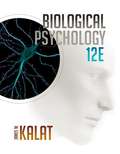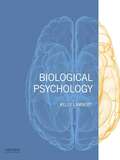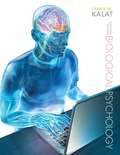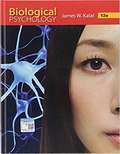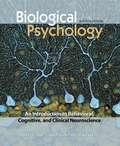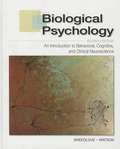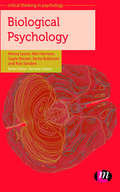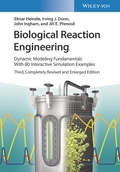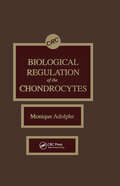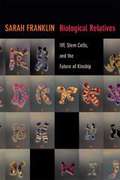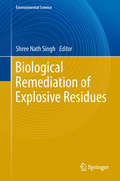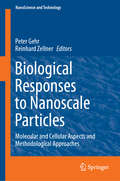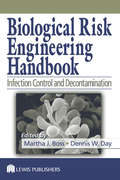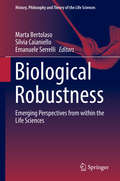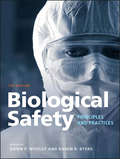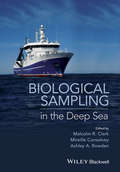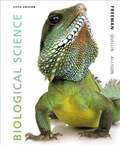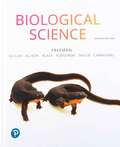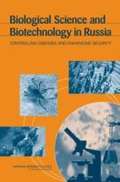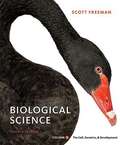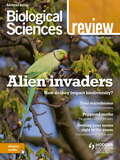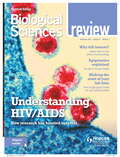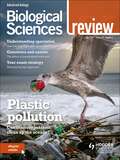- Table View
- List View
Biological Psychology
by James W. KalatDr. James W. Kalat's BIOLOGICAL PSYCHOLOGY is widely used for good reason: an extremely high level of scholarship, a clear writing style with amusing anecdotes, and precise examples. Kalat's goals are to make biological psychology accessible and to convey the excitement of the search for biological explanations of behavior, and he delivers. Updated with new topics, examples, and recent research findings, the new 12th edition continues this book's tradition of quality.
Biological Psychology
by Kelly G. LambertBlending classic scholarship with exciting new developments in the discipline, Biological Psychology offers a fresh perspective on the brain's interaction with its environment.
Biological Psychology (Eleventh Edition)
by James W. KalatThe most widely used text in its course area, Dr. James W. Kalat's BIOLOGICAL PSYCHOLOGY appeals to students and instructors alike. Throughout all eleven editions, the goal has been to make biological psychology accessible to psychology students, not just to biology majors and pre-meds. The goal has also been to convey the excitement of the search for biological explanations of behavior. Kalat believes that biological psychology is "the most interesting topic in the world," and this text convinces many students--and perhaps you, too--with its clear writing style, amusing anecdotes, and intriguing examples. A media-rich, highly interactive online eBook integrates the text with videos, animations, and an online bio-lab component, making it easier for you to learn.
Biological Psychology (Mindtap)
by James KalatThe most widely used text in its course area, James W. Kalat's BIOLOGICAL PSYCHOLOGY has appealed to thousands of students before you. Why? Kalat's main goal is to make Biological Psychology understandable to Psychology students, not just to Biology majors and pre meds--and he delivers. Another goal is to convey the excitement of the search for biological explanations of behavior. Kalat believes that Biological Psychology is "the most interesting topic in the world," and this text convinces many students--and maybe you, too--with clear writing, amusing anecdotes and intriguing examples. MindTap, an interactive online learning resource that integrates the text with videos, animations and a virtual bio-lab component, makes learning even easier and more enjoyable.
Biological Psychology: An Introduction to Behavioral and Cognitive Neuroscience
by S. Marc Breedlove Mark R. Rosenzweig Neil V. WatsonBiological Psychology is a comprehensive survey of the biological bases of behavior that is authoritative and up-to-date. Designed for undergraduates enrolled in Biological Psychology, Physiological Psychology, or Behavioral Neuroscience, the book continues to offer an outstanding illustration program that engages students, making even complicated topics and processes clear. It offers a broad perspective, encompassing lucid descriptions of behavior, evolutionary history, development, proximate mechanisms, and applications. The Sixth Edition features a thoroughly redesigned and up-to-date Cognitive Neuroscience module (Part VI; Chapters 17-19), with expanded coverage of attention, executive control, and decision-making processes, in keeping with the latest research breakthroughs. Optional advanced topics are available on the Web as "A Step Further," streamlining the printed text to emphasize the important points. The new edition boasts hundreds of new references, including research students may have encountered in the popular media. Yet critical thinking skills are also honed as the reader is alerted to the many widely held myths about the neuroscience of behavior and educated about facts that sound unlikely to the uninformed. Thorough and reader-friendly, Biological Psychology reveals the fascinating interactions of brain and behavior. KEY FEATURES * The book has an outstanding full-color art program, including hundreds of original illustrations that make it easy to understand structures, mechanisms, and processes in the brain. * Each chapter opens with a brief outline and a narrative illustrating an important aspect of behavioral biology that will be made clear to the student by reading the rest of the chapter. * Redesigned chapter summaries are organized by main chapter heads in a readable two-column format. Each has bold-faced key terms, callouts to pertinent figures, and references to the Companion Website.
Biological Psychology: An Introduction to Behavioral, Cognitive, and Clinical Neuroscience, Seventh edition
by S. Marc Breedlove Neil V. WatsonBiological Psychology, Seventh Edition is a comprehensive survey of the biological bases of behaviour designed for undergraduates enrolled in biological psychology, physiological psychology, or behavioural neuroscience courses. It offers a broad perspective, encompassing lucid descriptions of behaviour, evolutionary history, development, proximate mechanisms, and applications.
Biological Psychology: Learning Through Assessment (Critical Thinking in Psychology Series)
by Minna Lyons Sarita Robinson Neil Harrison Gayle Brewer Robert L. SandersThis accessible introductory text addresses the core knowledge domain of biological psychology, with focused coverage of the central concepts, research and debates in this key area. Biological Psychology outlines the importance and purpose of the biological approach and contextualises it with other perspectives in psychology, emphasizing the interaction between biology and the environment. Learning features including case studies, review questions and assignments are provided to aid students′ understanding and promote a critical approach. Extended critical thinking and skill-builder activities develop the reader′s higher-level academic skills.
Biological Reaction Engineering: Dynamic Modeling Fundamentals with 80 Interactive Simulation Examples
by Elmar Heinzle John Ingham Irving J. Dunn Jiří E. PřenosilThis practical book presents the modeling of dynamic biological engineering processes in a readily comprehensible manner, using the unique combination of simplified fundamental theory and direct hands-on computer simulation. The mathematics is kept to a minimum, and yet the 60 examples illustrate almost every aspect of biological engineering science, with each one described in detail, including the model equations. The programs are written in the modern user-friendly simulation language Berkeley Madonna, which can be run on both Windows PC and Power-Macintosh computers. Madonna solves models comprising many ordinary differential equations using very simple programming, including arrays. It is so powerful that the model parameters may be defined as "sliders", which allow the effect of their change on the model behavior to be seen almost immediately. Data may be included for curve fitting, and sensitivity or multiple runs may be performed. The results can be viewed simultaneously on multiple-graph windows or by using overlays. The examples can be varied to fit any real situation, and the suggested exercises provide practical guidance. The extensive teaching experience of the authors is reflected in this well-balanced presentation, which is suitable for the teacher, student, biochemist or the engineer.
Biological Regulation of the Chondrocytes
by Monique AdolpheBiological Regulation of the Chondrocytes provides a comprehensive examination of the various regulations in which cartilaginous cells are involved. The book's introductory chapter provides an overview of the different types of chondrocyte, while following chapters discuss the various biological regulations implicated in chondrocyte functions, especially the modulation of differentiative properties. Chapters 2 and 3 examine the extracellular matrix components, and Chapter 4 discusses the special case of cultured chondrocytes and the usefulness of in vitro approaches. The following three chapters focus on the complex role of cartilaginous growth factors and cytokines (FGF, TGFB, IGF, and IL1) on the modulation of the chondrocyte properties. Chapter 9 discusses the synoviocyte, and the last four chapters examine the biochemical and molecular perturbations that appear during repair, aging, rheumatic disease, and cancer. Biological Regulation of the Chondrocytes will benefit rheumatologists, pharmaceutical researchers, physiologists, connective tissue specialists, and students and other researchers in the osteoarticular field.
Biological Relatives: IVF, Stem Cells, and the Future of Kinship
by Sarah FranklinThirty-five years after its initial success as a form of technologically assisted human reproduction, and five million miracle babies later, in vitro fertilization (IVF) has become a routine procedure worldwide. In Biological Relatives, Sarah Franklin explores how the normalization of IVF has changed how both technology and biology are understood. Drawing on anthropology, feminist theory, and science studies, Franklin charts the evolution of IVF from an experimental research technique into a global technological platform used for a wide variety of applications, including genetic diagnosis, livestock breeding, cloning, and stem cell research. She contends that despite its ubiquity, IVF remains a highly paradoxical technology that confirms the relative and contingent nature of biology while creating new biological relatives. Using IVF as a lens, Franklin presents a bold and lucid thesis linking technologies of gender and sex to reproductive biomedicine, contemporary bioinnovation, and the future of kinship.
Biological Remediation of Explosive Residues (Environmental Science and Engineering)
by Shree Nath SinghMicrobial degradation, Phytoremediation, Remediation, Explosive residues, Biotransformation, Mineralization, Degradative Enzymes, Degradation Pathways, Energetics, Soil contamination, Water contamination.
Biological Response Signatures: Indicator Patterns Using Aquatic Communities
by Thomas P. SimonThe use of environmental assessment procedures within monitoring frameworks demands that there be some relevancy to the decisions that management agencies make using biological criteria. These biological criteria standards are the basis for environmental indicators, which provide a direct measure of environmental quality. Biological Response Signat
Biological Responses to Nanoscale Particles: Molecular and Cellular Aspects and Methodological Approaches (NanoScience and Technology)
by Peter Gehr Reinhard ZellnerIn this book the recent progress accumulated in studies of the interaction of engineered nanoparticles with cells and cellular constituents is presented. The focus is on manufacturing and characterization of nanosized materials, their interactions with biological molecules such as proteins, the mechanisms of transport across biological membranes as well as their effects on biological functions. Fundamental molecular and cellular aspects are in the foreground of the book. A further particularity is the interdisciplinary approach, including fields such as preparatory and analytical chemistry, biophysics and the physics of colloids, advanced microscopy and spectroscopy for in-situ detection of nanoparticles, cellular toxicology and nanomedicine. <P><P> Nanoscale particles are known to exhibit novel and unprecedented properties that make them different from their corresponding bulk materials. As our ability to control these properties is further advanced, a huge potential to create materials with novel properties and applications emerges. Although the technological and economic benefits of nanomaterials are indisputable, concerns have also been raised that nanoscale structuring of materials might also induce negative health effects. Unfortunately, such negative health effects cannot be deduced from the known toxicity of the corresponding macroscopic material. As a result, there is a major gap in the knowledge necessary for assessing their risk to human health.
Biological Risk Engineering Handbook: Infection Control and Decontamination (Industrial Hygiene Engineering)
by Martha J. Boss CSP Dennis W. DayThis handbook discusses biological risk engineering, an extension of industrial hygiene that involves the assessment, control, and decontamination of indoor biological risks. The book synergizes the knowledge of experts in various fields, from law to toxicology, to provide a compendium of information for applying science to limit biological risk.
Biological Robustness: Emerging Perspectives from within the Life Sciences (History, Philosophy and Theory of the Life Sciences #23)
by Marta Bertolaso Emanuele Serrelli Silvia CaianielloThis volume reviews examples and notions of robustness at several levels of biological organization. It tackles many philosophical and conceptual issues and casts an outlook on the future challenges of robustness studies in the context of a practice-oriented philosophy of science. The focus of discussion is on concrete case studies. These highlight the necessity of a level-dependent description of robust biological behaviors.Experts from the neurosciences, biochemistry, ecology, biology, and the history and the philosophy of life sciences provide a multiplex perspective on the topic. Contributions span from protein folding, to cell-level robustness, to organismal and developmental robustness, to sensorimotor systems, up to the robustness of ecological systems.Several chapters detail neurobiological case-studies. The brain, the poster child of plasticity in biology, offers multiple examples of robustness. Neurobiology explores the importance of temporal organization and multiscalarity in making this robustness-with-plasticity possible. The discussion also includes structures well beyond the brain, such as muscles and the complex feedback loops involved in the peculiar robustness of music perception. Overall, the volume grounds general reflections upon concrete case studies, opening to all the life sciences but also to non-biological and bio-inspired fields such as post-modern engineering. It will appeal to researchers, students, as well as non-expert readers.
Biological Safety: Principles and Practices (ASM Books #31)
by Dawn P. Wooley Karen B. ByersBiological safety and biosecurity protocols are essential to the reputation and responsibility of every scientific institution, whether research, academic, or production. Every risk—no matter how small—must be considered, assessed, and properly mitigated. If the science isn't safe, it isn't good. Now in its fifth edition, Biological safety: Principles and Practices remains the most comprehensive biosafety reference. Led by editors Karen Byers and Dawn Wooley, a team of expert contributors have outlined the technical nuts and bolts of biosafety and biosecurity within these pages. This book presents the guiding principles of laboratory safety, including: the identification, assessment, and control of the broad variety of risks encountered in the lab; the production facility; and, the classroom. Specifically, Biological Safety covers protection and control elements—from biosafety level cabinets and personal protection systems to strategies and decontamination methods administrative concerns in biorisk management, including regulations, guidelines, and compliance various aspects of risk assessment covering bacterial pathogens, viral agents, mycotic agents, protozoa and helminths, gene transfer vectors, zooonotic agents, allergens, toxins, and molecular agents as well as decontamination, aerobiology, occupational medicine, and training A resource for biosafety professionals, instructors, and those who work with pathogenic agents in any capacity, Biological safety is also a critical reference for laboratory managers, and those responsible for managing biohazards in a range of settings, including basic and agricultural research, clinical laboratories, the vivarium, field study, insectories, and greenhouses.
Biological Sampling in the Deep Sea
by Mireille Consalvey Ashley A. Rowden Malcolm R. ClarkThe deep sea covers over 60% of the surface of the earth, yet less than 1% has been scientifically investigated. There is growing pressure on deep-sea resources and on researchers to deliver information on biodiversity and the effects of human impacts on deep-sea ecosystems. Although scientific knowledge has increased rapidly in recent decades, there exist large gaps in global sampling coverage of the deep sea, and major efforts continue to be directed into offshore research. Biological Sampling in the Deep Sea represents the first comprehensive compilation of deep-sea sampling methodologies for a range of habitats. It reviews the real life applications of current, and in some instances developing, deep-sea sampling tools and techniques. In creating this book the authors have been able to draw upon the experiences of those at the ?coal face? of deep-sea sampling, expanding on the existing methodological texts whilst encompassing a level of technical detail often omitted from journal publications. Ultimately the book will promote international consistency in sampling approaches and data collection, advance the integration of information into global databases, and facilitate improved data analyses and consequently uptake of science results for the management and conservation of the deep-sea environment. The book will appeal to a range of readers, including students, early-career through to seasoned researchers, as well as environmental managers and policy makers wishing to understand how the deep-sea is sampled, the challenges associated with deep survey work, and the type of information that can be obtained.
Biological Science
by Scott Freeman Michael Black Emily Taylor Kim Quillin Lizabeth Allison Greg Podgorski Jon MonroeBiological Science, Fifth Edition contains many new or expanded features, all of them targeted at ways to help students learn to construct their own knowledge and think like biologists. The book provides scaffolding to help students learn at the level called for by the National Academy of Sciences, the Howard Hughes Medical Institute, the American Association of Medical Academies, and the National Science Foundation.
Biological Science
by Scott Freeman Michael Black Emily Taylor Kim Quillin Lizabeth Allison Greg Podgorski Jeff CarmichaelFor introductory courses for biology majors. Discover biology, develop skills, and make connections Known for its discovery-based, student-centered approach, Scott Freeman’s Biological Science emphasizes higher-order thinking, enhances skill development, and promotes active learning. Biological Science equips students with strategies that go beyond memorization and guides them in making connections between core concepts and content, underscoring principles from the Vision and Change in Undergraduate Biology Education report. Students learn to apply their knowledge throughout the course, assess their level of understanding, and identify the types of cognitive skills that need improvement. The 7th Edition enables students to see that biology concepts are connected by weaving one case study throughout the entire text, helping students make connections across biology. New content includes updated coverage of advances in genomic editing, global climate change, and recent insights into the evolution of land plants. New embedded Pearson eText assets support content in the text with whiteboard Making Models videos, Figure Walkthrough videos, and BioFlix animations that engage students, help them learn, and guide them in completing assignments.
Biological Science (Fifth Edition)
by Scott Freeman Kim Quillin Lizabeth AllisonThis edition features the exact same content as the traditional text in a convenient, three-hole-punched, loose-leaf version. Books a la Carte also offer a great value for your students--this format costs 35% less than a new textbook. Supports and motivates you as you learn to think scientifically and use the skills of a biologist. Scott Freeman's Biological Science is beloved for its Socratic narrative style, its emphasis on experimental evidence, and its dedication to active learning. In the Fifth Edition, the author team has expanded to include new members --bringing a fresh focus on accuracy and currency, and multiplying the dedication to active learning by six. Research indicates that true mastery of content requires a move away from memorization towards active engagement with the material in a focused, personal way. Biological Science is the first introductory biology text designed to equip you with a strategy to accurately assess your level of understanding, predict your performance, and identify the types of cognitive skills that need improvement. Package Components: Books a la Carte for Biological Science, Fifth Edition
Biological Science and Biotechnology in Russia: CONTROLLING DISEASES AND ENHANCING SECURITY
by National Research Council of the National AcademiesIn July 2005, the National Academies released the report Biological Science and Biotechnology in Russia: Controlling Diseases and Enhancing Security. The report offered a number of recommendations that could help restore Russia’s ability to join with the United States and the broader international community in leading an expanded global effort to control infectious diseases. A proposed bilateral intergovernmental commission could play a pivotal role toward that end as cooperation moves from assistance to partnership. The report proposed the establishment of two model State Sanitary Epidemiological Surveillance Centers in Russia, more focused support of competitively selected Russian research groups as centers of excellence, the promotion of investments in biotechnology niches that are well suited for Russian companies, and expanded opportunities for young scientists to achieve scientific leadership positions in Russia. Also, the report highlighted the importance of U.S. programs that support the integration of former Soviet defense scientists with civilian researchers who had not been involved in military-related activities.
Biological Science, Volume 1: The Cell, Genetics, and Development (4th Edition)
by Scott FreemanBuilding upon Scott Freeman's unique narrative style that incorporates the Socratic approach and draws you into thinking like a biologist, the Fourth Edition has been carefully refined to motivate and support a broader range of learners as they are introduced to new concepts and encouraged to develop and practice new skills. Each page of the book is designed in the spirit of active learning and instructional reinforcement, equipping novice learners with tools that help them advance in the course-from recognizing essential information in highlighted sections to demonstrating and applying their understanding of concepts in practice exercises that gradually build in difficulty.
Biological Sciences Review Magazine Volume 31, 2018/19 Issue 1
by Philip Allan MagazinesThis A-level magazine makes cutting-edge biology research accessible and relevant for students, supporting them to get their best grade. Featuring the latest thinking on advanced topics, Biological Sciences Review aims to challenge students and increase their confidence with data, technical terms, practical experiments and exam skills.ContentsYour microbiome: what it is and why it matters Elle Lindsay The Atlantic ghost crab Martin Rowland and Geremis Luces Vital statistics Distributions and descriptive statistics Robert Spooner Upgrade New terms for a new term Martin Rowland Melanism and morphs: the genetics behind the peppered moth story Tom Parry Saffron Peter Gould and Liz Sheffield Using insects to protect crops: biological control of aphids Lucy Alford Spotlight The life cycle of a honeybee queen Leo Gamberini Prospects Becoming a patent attorney Dean Houston Could rabies be eliminated? How to eradicate a disease Sarah Cleaveland Impact Alien invaders: a tale of two crayfish Zara Gladman Images of biology Bee-eaters in aerial combat Rob Beynon and Jane Hurst
Biological Sciences Review Magazine Volume 31, 2018/19 Issue 2
by Philip Allan MagazinesThis A-level magazine makes cutting-edge biology research accessible and relevant for students, supporting them to get their best grade. Featuring the latest thinking on advanced topics, Biological Sciences Review aims to challenge students and increase their confidence with data, technical terms, practical experiments and exam skills. ContentsHIV: knowledge is power Michael McKenna Bioethics Inside the killing jar: why entomologists kill insects Adam Hart Making a muscle Teresa Audesirk Antibody protein structure Martin Rowland The genome remixed: epigenetics and human disease Paul Shiels, Laura Monaghan and Ognian Neytchev Banana blight Liz Sheffield and Kevin O'Dell Spotlight The curious biology of the naked mole-rat Chris Faulkes Upgrade Testing practical skills Martin Rowland Congenital heart disease Donna Page Prospects Technical paths into a world of research Lisa Jameson What is...? Immunology Phoebe Sharp Images of biology Collagen connections Marion Leibl
Biological Sciences Review Magazine Volume 31, 2018/19 Issue 4
by Philip Allan MagazinesThis A-level magazine makes cutting-edge biology research accessible and relevant for students, supporting them to get their best grade. Featuring the latest thinking on advanced topics, Biological Sciences Review aims to challenge students and increase their confidence with data, technical terms, practical experiments and exam skills.ContentsMarine bacteria and the plastisphereRobyn WrightBioethicsTackling cancer: getting personalChris WilmottSnake venomMax Drakeley, Liz Sheffield and Catherine McCrohanThe measure of a monkey: speciation and hybridsDuncan WrightProspectsFeeding the futureJoseph MoughanWhat is...?Sympatric speciationRobert Spooner and Raksha GohelProtecting the pinosaurLiz SheffieldLampreysCatherine McCrohanWhat is...?A ring speciesRobert Spooner and Raksha GohelStillbirthStacey Lee and Megan SharpsOutside the boxMaking sense of bird bristlesWater: transport and regulation in the bodyKevin MoffatUpgradeExams? You need a strategyMartin Rowland
